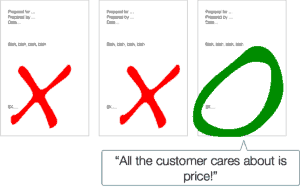Have you spent months carefully developing an opportunity, invested hours in creating a polished proposal, only to have the prospect tell you that they went with a cheaper option?
We’ve all been there. It’s frustrating and we might gripe, “they say they care about quality (or results or service or efficiency or whatever), but all they really care about is price!”
Now think about when you buy things. When was the last time you bought the absolute cheapest option you could find? I asked a roomful of people in a workshop this question, and one gentleman said he bought the cheapest car he could find. I don’t remember what it was, but it was about $13,000. I asked him how he liked it. “I hated it. My next car was a BMW.”
The thing is, he could have spent even less (and probably been much happier) with a used car. But a new car was one of his criteria. Beyond that, anything would do. There was no incremental value (at the time) beyond having a “new” car. But whatever he chose had to meet that threshold. No used cars. No motorcycles. No bikes or walking. If you’re reading this, you might consider this line of reasoning absurd, but for billions of people, this is how they consider transportation options.
We almost never pick the cheapest thing we can find in a category. Even price conscious buyers (like me) have some set of qualifications they need their purchase to meet.
What happens if you offer more than your buyer’s minimum criteria?
- They may not perceive any incremental value. It’s literally invisible to them. You can try to point it out, but it may not register. you have no pricing power here. Also, if you discount to get the business, you risk diluting your positioning with the parts of the market that do perceive that extra value.
- They may perceive some value, but not enough to justify the extra price. You might win, you might lose, but you’re not going to get full price. See above for discounting risks.
- They perceive the extra value and think it’s a great investment. These customers are happy to spend a little bit more, because they perceive the return to be worthwhile. Great stuff!
Unfortunately, the sales process often pushes people “down” the ladder of value perception, rather than helping them climb “up”.
The typical sales proposal is full or regard for the seller, and treats the buyer with contempt. (This is not the intention, of course.) Think about proposals you may have read as a buyer. There’s typically lots of stuff about how awesome the seller is, how cool the offerings are, and what you need to pay.
When the buyer has a selection of these proposals, none of which really speak to their story, it’s hard to perceive differential value, so what happens? The buyer goes to what they can compare: price.
As I’ve said again and again, a proposal is a story, not a brochure. And the hero of the story is the customer, not you.
To make your proposal stand out and stand a chance to deliver and capture differential value, you have to make sure you’re telling the customer’s story, in the customer’s language, with the stuff the customer considers important.
You can present the same number to the same prospect in 2 different ways. One way can have your buyer eager to sign and get started. The other leads to a lost deal or massive discounts.
(If this is a problem in your business, and you’d like to straighten it out, come join in San Diego on October 25 for a workshop with the Professional Pricing Society to help you close more deals at higher prices. Early bird pricing ends September 15.)

